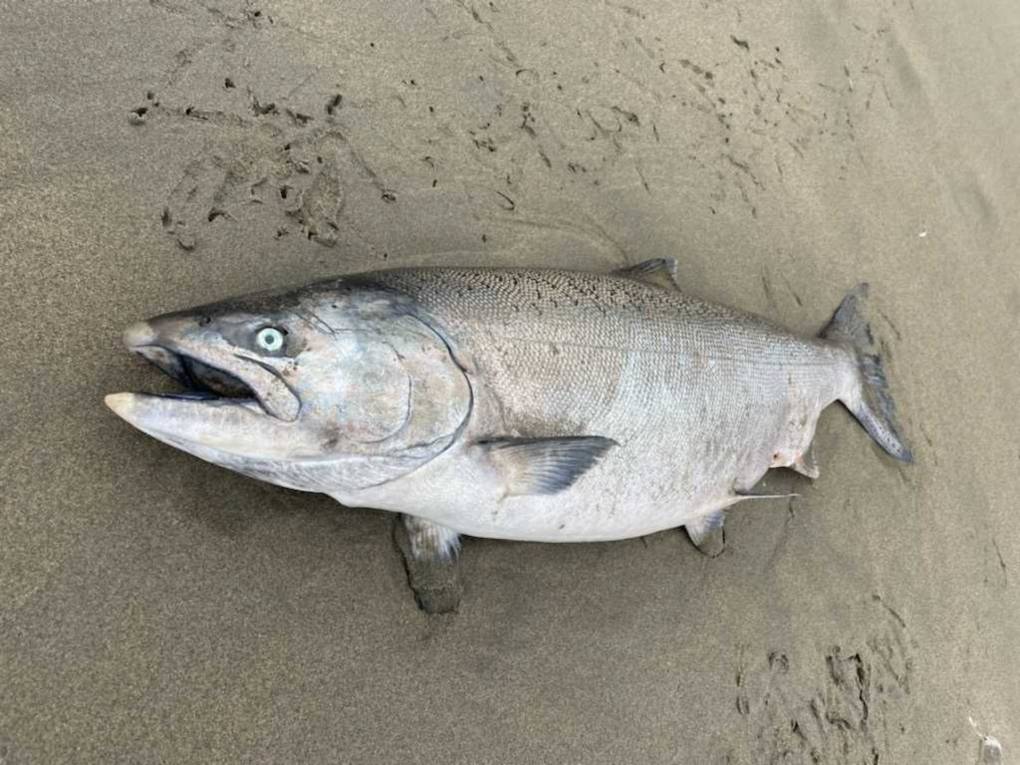
When KQED showed a social media video of dead fish piling up at the edge of Lake Merritt, Johnson said, "That's a pretty powerful image. Yeah, that's not good."
Damon Tighe, who describes himself on his LinkedIn profile as an educator and a naturalist who studies mycology, tweeted a photo of a pile of dead fish at Lake Merritt on Sunday.
"Massive fish die off going on right now in Lake Merritt," tweeted Tighe. "May be related to the huge algal bloom that’s been happening on the east bay since the start of the month in front of Alameda where effluent flows." Tighe included a link to iNaturalist, a nature app that allows users to share their observations with other scientists and naturalists.
Massive fish die off going on right now in Lake Merritt #oakland #fish #lakemerritt
May be related to the HUGE algal bloom that’s been happening on the east bay since the start of the month in front of Alameda where effluent flows…https://t.co/1H1byxoWOk pic.twitter.com/FJBAU0InIb
— Damon Tighe (@damontighe) August 28, 2022
The algal bloom likely leading to the mass fish death is Heterosigma akashiwo, which SF Baykeeper and the San Francisco Estuary Institute and Aquatic Science Center have been tracking since it appeared in the last month. The aquatic science center noted that fish-kill reports began emerging around August 22, though they noted the Bay's size makes data gathering a "huge challenge."
What has changed, Rosenfield said, is those reports finally coming in, as well as confirmation from field investigators this weekend.
The algal bloom that Rosenfield says is most likely causing the die-off he says is caused by a mix of environmental conditions, perhaps worsened by climate change, and treated sewage put out by wastewater treatment plants across the Bay Area. The red tide species of algae, Heterosigma, may be killing fish in two ways: it can produce a toxin that is deadly to fish, but it can also result in low dissolved oxygen levels in the water which can also be deadly.
"So we're not sure of which mechanism is operating here. Maybe it's both," Rosenfield said. But the same bloom has caused massive fish kills in other parts of the world, as well.
The change that spurred the bloom locally, Rosenfield said, was likely a tipping point in warming waters. The solution, then, is for wastewater treatment plants to begin recycling wastewater in far higher volumes than it does now.
An April 2022 report by the environmental group called the Pacific Institute described wastewater recycling as under-utilized across California. The group estimates that an additional 1.8 million to 2.1 million acre-feet per-year of municipal wastewater is available for reuse in California.
San Francisco Supervisor Aaron Peskin, an avid swimmer with the South End Rowing Club, saw the red tide himself as he took a dip last week, on Tuesday, Wednesday, and Thursday.
"My wife said I can't swim in there anymore," said Peskin. "I told her about it. It was like swimming through rust."
He's started to see the problem on the shores, too. His constituents have already started sending him photos of dead fish on San Francisco beaches. Peskin's district includes Fisherman's Wharf and the Embarcadero, all areas with borders that touch the water. Peskin wants to ensure those areas, and beyond, see climate action.
"Our public utilities commission, which is our sewer purveyor, needs to quickly come up with strategies to how San Francisco can do its part in reducing discharges that can exacerbate red tides," Peskin said.
Johnson, from the water quality control board, pushed back on the assertion that wastewater is to blame — the jury is still out, he says.
He says the water control board is spending $2.2 million annually to fund scientists studying the algal bloom to see if it is indeed caused by human wastewater.
"So if the solution is to ask the wastewater community to spend billions and billions of dollars for nutrients, then that's what we're going to do," Johnson said. "But if the underlying causes are something else and if investing all that money isn't going to solve the problem, we need to know that before we take that measure."
Understanding what's causing the algal bloom is crucial, Rosenfield said, because it is almost certainly not a one-off. Without preventative measures, this could be an annual occurrence, rising when the waters warm, and fading as they cool.
It's already beginning to spook Rosenfield, who isn't easy to spook — he's been a senior scientist at SF Baykeeper for four years, and was a lead scientist at The Bay Institute for nearly 11 years.
What really rocked him was seeing a number of a particular white sturgeon, a rare fish part of a recreational fishery, show up dead on Stinson Beach.
They don't wind up dead nearly as easily, being large, armored fish.
"Seeing that sturgeon is an indicator of a much larger problem," he said.
Like a canary in a coal mine, but with scales.
"fish" - Google News
August 25, 2022 at 08:00PM
https://ift.tt/LIUFP9i
Dead Fish Are Piling Up Across Shores of San Francisco Bay, Lake Merritt, as Algal Bloom Grows - KQED
"fish" - Google News
https://ift.tt/uCoF5NG
https://ift.tt/eKM8IE6
Bagikan Berita Ini















0 Response to "Dead Fish Are Piling Up Across Shores of San Francisco Bay, Lake Merritt, as Algal Bloom Grows - KQED"
Post a Comment